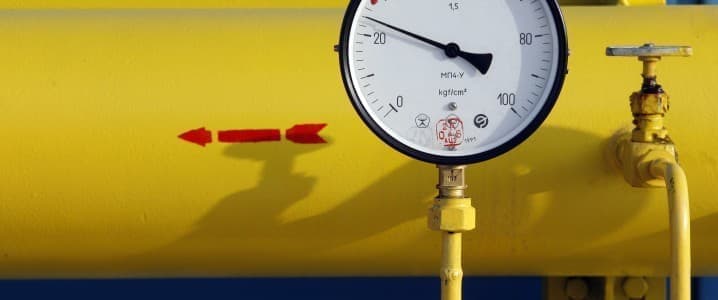
Gas Markets Remain Bearish As Inventories Rise At A Record Clip
A couple of weeks ago, the International Energy Agency (IEA) warned that natural gas prices may spike again this winter, forcing governments to subsidize bills, again. The IEA’s executive director said: “In a scenario where the Chinese economy is very strong, buys a lot of energy from the markets and we have a harsh winter, we may see strong upward pressure under natural gas prices, which in turn will put an extra burden on consumers.” IEA executive director Fatih Birol told BBC Radio.
But not everybody is ready to buy into that bullish thesis, with commodity analysts at Standard Chartered arguing that natural gas price risk remains skewed to the downside.
StanChart notes that gas inventories continue rising at a rapid clip despite the current European heatwave and increased electricity demand for cooling. According to Gas Infrastructure, Europe (GIE) data, EU gas inventories stood at 94.52 billion cubic meters (bcm) on 16 July, a good 21.73bcm higher y/y and 18.46 bcm above the five-year average.
The much-awaited buying frenzy by the EU as it looks to fill its gas stores ahead of winter has yet to materialize. Europe imported 9.50 million metric tons in June, down from 12.11 million in May and the lowest monthly total since August 2022. Rocked by one of the worst energy crises in living memory, the European Union launched a gas buyers’ cartel in 2022 and started issuing tenders for supplies. According to Sefcovic, some 50 gas suppliers and large industrial gas consumers in the EU immediately expressed interest in being part of the bloc’s joint gas-buying effort. A key objective of the whole endeavor is to keep gas prices low by buying in larger volumes.
Well, Europe’s gas buyer’s club has been a resounding success, with the continent’s gas stores nearly 80% full. Unfortunately, Europe’s purchases of U.S. LNG have also dwindled, with June’s volumes clocking in at 4.15 million metric tons, down from 5.63 million tons in May.
Meanwhile, U.S. gas inventories have also been ticking higher, with stocks for the week ended July 14, 2023, up 49 Bcf to 2,930 Bcf.
Excess gas inventories in Europe and the U.S. remain the biggest bearish catalyst that’s capping gas prices, and it will take an extraordinarily black swan event for the situation to turn around. The big problem here is that not only are gas inventories rising but are doing so at a torrid clip.
StanChart notes that for inventories to finish the injection season at an all-time high, they would need to increase by more than 40.6% of the five-year average build from this point. However, the commodity experts say that inventories are building up at a far faster pace than that critical level, with the average build over the past week of 330 million cubic meters per day (mcm/d) nearly 100% higher than the five-year average over the equivalent period. If the current rate of gas injection is maintained, inventories will finish the injection season at just above 120 bcm, more than 10 bcm above the record-high.
The deluge of gas has put nearby futures prices under immense pressure, with futures for gas delivered in October 2023 now trading at a discount of almost 12 euros per megawatt-hour to prices for April 2024. In contrast, they traded at a premium of more than 5 euros at the beginning of the year and a full 38 euros a year ago.
China and Asia Become Key U.S. Customers
But it’s not all doom and gloom for U.S. gas producers, with Asia and China picking up the slack left by Europe.
Asia’s imports of U.S. LNG climbed to 1.34 million metric tons in June, up from 1.21 million in May, the most since February. Indeed, China and Asia are now the U.S. biggest LNG customers, a position Europe held last year when it purchased as much as 65% of U.S. output.
The United States’ largest producer of LNG, Cheniere Energy (NYSE:LNG), has signed a long-term liquefied natural gas (LNG) sale and purchase agreement with China’s ENN Energy Holdings.
ENN will purchase ~1.8M metric tons/year of LNG on a free-on-board basis at Henry Hub prices for a 20-year term, with deliveries to commence mid-2026 ramping up to 0.9 million tonne per annum (mtpa) in 2027. Last year, ENN signed a 13-year deal with Cheniere to purchase 900K metric tons/year, again based on Henry Hub prices.
The deal is subject to the completion of Cheniere’s Sabine Pass project, which is being developed to include up to three liquefaction trains with an expected total production capacity of ~20M tons/year of LNG.
Currently, Sabine Pass has six fully operational liquefaction units aka ?“trains”, each capable of producing ~5 mtpa of LNG for an aggregate nominal production capacity of ~30 mtpa. Cheniere processes more than 4.7 billion cubic feet per day of natural gas into LNG. Sabine Pass has multiple pipeline connections to interstate and intrastate pipelines, and is located less than four nautical miles from the Gulf of Mexico thus providing easy access to seafaring vessels.
Previously, Cheniere entered another long-term liquefied natural gas sale and purchase agreement with Norway’s national oil company Equinor ASA (NYSE:EQNR) that will see Equinor purchase 1.75M metric tons/year of LNG on a free-on-board basis for a purchase price indexed to the Henry Hub price, for a 15-year term.